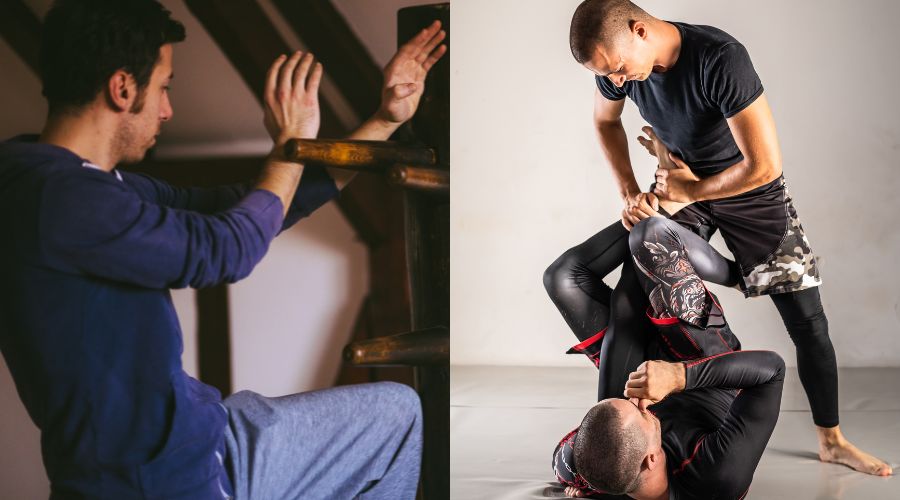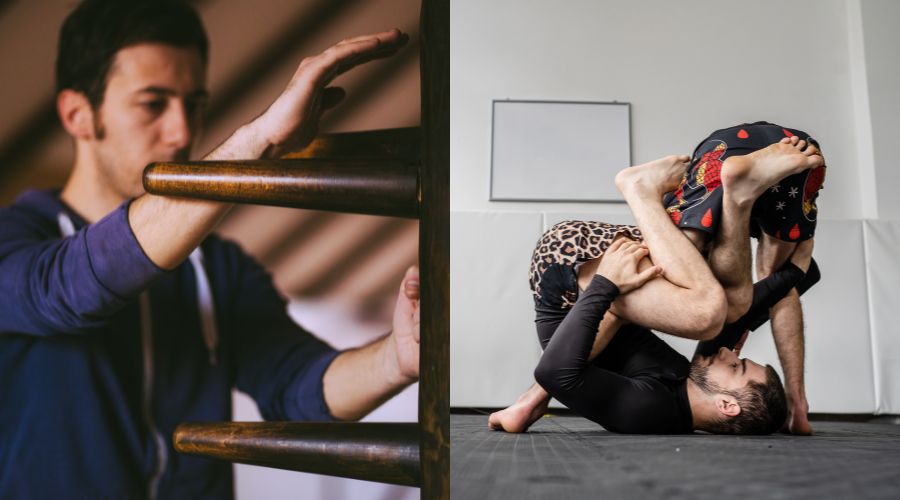The debate about which is better for actual fighting – combat sports or self-defense systems is never-ending. Both sides have strong proponents, although both sides have different degrees of visual proof. Brazilian jiu-jitsu started as a self-defense system, but it’s most popular as a fully-fledged combat sport and is often compared with Wing Chun, a martial art focused on self-defense.
The critical comparison between the two should be about their real-world effectiveness. So, how do they stack against each other?
BJJ has both a self-defense and sports element. While many of the sports-specific techniques are unsuitable for a street fight, the constant pressure testing of the fundamentals of BJJ in training has proven effective for self-defense. Wing Chun is solid in theory. It can also be effective if practiced with regular sparring and pressure tested.
While this sums up the most important comparison between the two martial arts, they include a lot more than mere practicality, so we’ll dive in deeper to see what they may offer to martial artists.
What Is BJJ
Brazilian Jui-jitsu is a martial art and a well-developed combat sport. Its entire focus is on ground fighting, and the approach is highly methodical, following a step-by-step method to ensure dominance on the ground through leverage, positioning, and submissions.
BJJ was developed in Brazil and is heavily based on early judo and catch wrestling. A Japanese master named Mitsuyo Maeda traveled to Brazil in the early 20th century and started teaching students.
Among them, the Gracie brothers proved instrumental as they gradually focused more on ground fighting than throwing and developed their unique style.
What started as a fighting system for self-defense and no-rules fights eventually evolved into a grappling-only style.
While BJJ became popular thanks to the explosion of MMA and the wins of Royce Gracie in the first UFC events, today, most people train jiu-jitsu in its sports version.
The accessibility to all kinds of people, in combination with the relatively low risk compared to other combat sports, make jiu-jitsu one of the most practiced and quickly growing martial arts on the planet.
What Is Wing Chun
Wing Chun is a Chinese martial art and form of kung fu emphasizing close-quarters hand-to-hand combat. The system is conceptual, focuses on capturing the opponent’s center line, and blends attack and defense into one.
The exact origins of Wing Chun are uncertain because eight distinct lineages from Southern China can be credited with the early development of the style. What is certain is how it became popular in more recent times.
The first surge of popularity came when Master Ip Man started teaching in Hong Kong and China, with Bruce Lee becoming his most famous student. The first athletic commission was created in 1967 and helped the style grow internationally.
Today, Wing Chun remains a popular martial art worldwide, with countless schools, some of which are unified in organizations while others are not.
Key Differences Between BJJ and Wing Chun

Features And Objectives
The best way to start comparing the two martial arts is by listing their key features, main focus, and objectives before diving into the finer details.
BJJ Key Features
- Grappling only. Limited striking is included only in self-defense BJJ
- Uses a systematic approach of getting an opponent to the ground, securing a dominant position, and then finishing the fight with a submission
- The vast majority of schools are focused on sports, jiu-jitsu, which has a well-developed competition scene
- In sports jiu-jitsu, a match can be won by submissions or through the accumulation of points
- Points are awarded for securing takedowns and dominant positions
- There are two distinct versions depending on the apparel- gi and no-gi
Wing Chun Key Features
- Primarily a striking system, with very limited grappling
- It focuses on close-range, hand-to-hand combat
- The emphasis of the striking is to capture and stick to the opponent’s center line.
- It’s mainly a self-defense system
- Most schools do not engage in competitions
Techniques
Jiu-jitsu’s domain is the ground, and most techniques are for use there. Positions are crucial, and one must be proficient in all the major positions like guard, mount, back control, side control, and others, both defensively and offensively.
To finish a fight, jiu-jitsu relies on many submission holds, including joint locks, chokes, strangulations, and others. They can either elicit a submission from the opponent or deal serious damage if he refuses to admit defeat.
As a striking system, Wing Chun has attacks with both the hands and feet. The punches are distinctive from all other styles and are straight, short, and often fired in rapid succession.
All attacks are aimed at the opponent’s center and his vital points there. Hand trapping and deflections are also core parts of the Wing Chun arsenal.
Kicks also follow the same philosophy and are economical, efficient, and straightforward.
Training

While the techniques are completely different in the two martial arts, there is another crucial difference that determines their respective effectiveness in more realistic avenues: training.
Brazilian jiu-jitsu training is all oriented towards pressure testing in isolated scenarios with resistance and free sparring. This constant testing of what works and what doesn’t against a fully resisting opponent is why jiu-jitsu is so good and constantly evolves.
Wing Chun training focuses on doing techniques in the air, forms, and partner drills with cooperative partners or light resistance. This may be a safe and enjoyable way to train, but there are more effective ways to learn how to fight.
With that said, there are academies where sparring is used, which, in my opinion, is immeasurably superior and resolves many of the problems Wing Chun has.
Equipment
Depending on what kind of BJJ you practice- gi or no-gi there is a slight difference in what gear you will need. Here is a list of everything you need for BJJ training:
- A BJJ gi
- Rash guards
- BJJ shorts
- Spats
- Mouthguard
- Optional headgear
- Optional elbow and knee pads
Wing Chun training includes wooden dummies, swords, poles, and others, but the academy usually provides them, so the personal list of equipment is shorter.
- Wing Chun uniform
- Athletic clothes, if the uniform is not mandatory
- Shoes
- Headgear, appropriate gloves, and shin guards if there is sparring in the school
BJJ vs. Wing For MMA
No serious people could claim BJJ is not better than Wing Chun for mixed martial arts. Jiu-jitsu has been a core part of the sport since day one and remains crucial for every fighter to learn.
The same cannot be said about the Chinese martial art, which has often failed to be effective. But can it be used?
Like some other traditional martial arts, Wing Chun techniques and concepts can work, but not without modification.
It seems only people who already know how to fight can make martial arts like Wing Chun effective.
As you will see in the video below, elite fighters like Jon Jones, Tony Ferguson, and Anderson Silva have used typical Wing Chun techniques in the cage and had success with them.
But remember, these fighters have thousands of hard sparring rounds on their feet and the ground, through which they build the ability to fight against an aggressive opponent. Something that should be done in Wing Chun practice.
Bruce Lee is perhaps the most famous practitioner of Wing Chun, and he said it best: ” Absorb what is useful and eliminate what is useless. “
There are techniques and principles from Wing Chun that work in mixed martial arts, and some people online are making a good transition. But again, these people can already fight and test what works in regular sparring.
Without pressure testing, even the best techniques won’t work.
There are even some rare examples of Wing Chun masters who manage to use their skills as intended, at least from a striking perspective. Here is one such gem.
BJJ vs. Wing Chun For Self-Defense
While even hardcore Wing Chun practitioners generally agree jiu-jitsu is superior in MMA, the debate about self-defense applications is very different. Wing Chun claims to be mainly a self-defense and street fighting system and should be superior.
Wing Chun is designed to be used in close quarters and deliver fast, straightforward attacks.
In theory, this sounds wonderful for actual fighting, but the problem is this usually remains a theory. In the vast majority of Wing Chun, there is no sparring; if there is, it’s too light and constricted to get any realistic feedback on what happens in a real fight.
Furthermore, the short punches of Wing Chun will not always be enough to incapacitate an aggressive attacker in full rage mode.
When adrenaline is high, attacks usually need to be more decisive. But, the key problem with Wing Chun is not the techniques and principles but the way of training, which does little to prepare practitioners for actual conflicts.
On the other hand, BJJ is so effective precisely because skills are pressure-tested in every practice.
Even without competition, sparring is often full power, and you always get realistic feedback on what works for you and what doesn’t against all kinds of people and builds.
Yes, jiu-jitsu is not perfect and has trouble dealing with multiple attackers or people who can’t be taken down.
Still, it has been proven repeatedly effective in many situations, while Wing Chun usually remains in theory land.
In defense of Wing Chun, some schools have hard sparring, and guys practicing this way are actually decent fighters and undoubtedly will have success over untrained attackers.
Who Would Win A Fight Between BJJ And Wing Chun?
Regardless of how legitimate the fighting skills of a Wing Chun practitioner are and if he spars or not, the battle between BJJ and Wing Chun is a typical striker vs. grappler, which usually ends the same way: the striker gets dominated on the ground.
Wing Chun is one of the worst striking styles in this matchup because it excels in close-quarter fighting, precisely where the jiu-jitsu practitioner wants to be.
While some striking styles like boxing or Muay Thai may have the footwork and firepower to deliver the rare knockout against a grappler, Wing Chun has none of these tools.
But let’s not remain simply on theoretical grounds. More than a few brave Wing Chun guys have fought with jiu-jitsu practitioners so that we can see the results in practice.
BJJ vs. Wing Chun: Which is Better
Each martial art has its value. As someone who values practicality and realism, I will always lean towards martial arts with a strong competitive nature and full-contact sparring, so BJJ is much better for me.
But Wing Chun has its value both culturally and as a fighting style. Many techniques and concepts are good and effective, and only the training methodology makes them useless in most cases.
But practitioners who spar and good fighters, in general, can make Wing Chun an effective martial art, and if striking is your preferred discipline, the straightforward nature of Wing Chun might be right for you if you have access to a good school.
